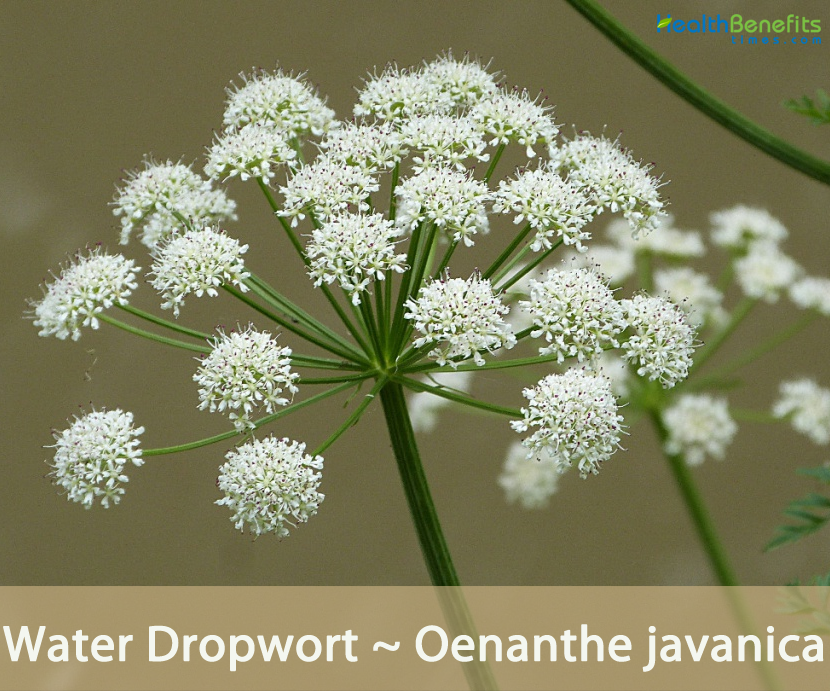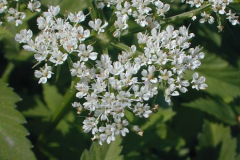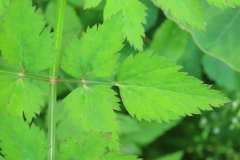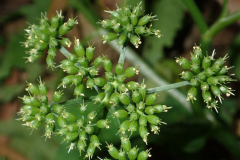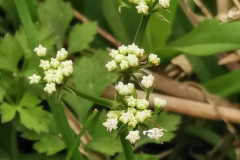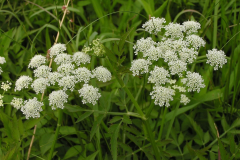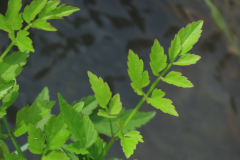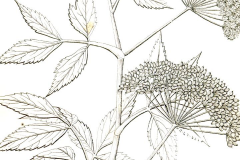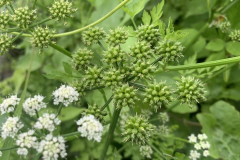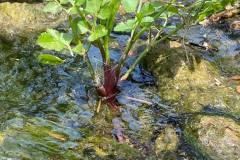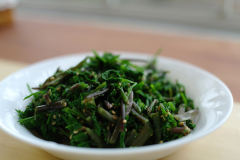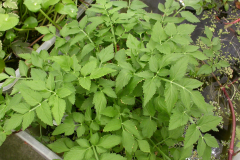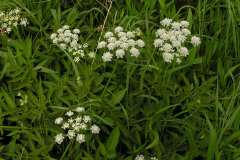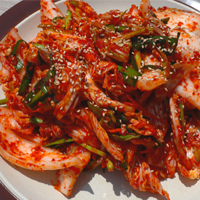| Water Dropwort Quick Facts | |
|---|---|
| Name: | Water Dropwort |
| Scientific Name: | Oenanthe javanica |
| Origin | South, Southeast and East Asia, from Pakistan to Japan and Taiwan and from northern China to tropical Australia |
| Shapes | Fruit about 2.5 mm. long, 2 mm. across, and slightly compressed; they are broadly ellipsoid in shape and hairless |
| Taste | Grassy, slightly spicy and bitter taste |
| Health benefits | Support for epidemic influenza, fever and discomfort, jaundice, hematuria, metrorrhagia, acute hepatitis, alcohol hangovers, abdominal pain, hypertension and urinary difficulties |
| Name | Water Dropwort |
|---|---|
| Scientific Name | Oenanthe javanica |
| Native | South, Southeast and East Asia, from Pakistan to Japan and Taiwan and from northern China to tropical Australia (Queensland) |
| Common Names | Water Dropwort, Java waterdropwort, Stolon waterdropwort, Japanese parsley, Chinese celery, Vietnamese parsley, Japanese parsley, water celery, Indian pennywort and Indian rye herb |
| Name in Other Languages | Afrikaans: Water druppelwortel Albanian: Ujëvrasës Amharic: Yewiha t’ebita (የውሃ ጠብታ) Angami: Gakra Arabic: qatarat alma (قطرات الماء) Armenian: Jri kat’il (ջրի կաթիլ) Azerbaijani: Su damcısı Bengali: Jala ḍrapa ōrṭa (জল ড্রপওর্ট) Bulgarian: Vodna kapka (водна капка) Burmese: Ray dropwort Chinese: Shuǐdī cǎo (水滴草), Shui qin (水芹), Shui qui cai (水芹菜 ) Croatian: Kapljica vode Czech: Kapka vody Danish: Vand dropwort Dutch: Water dropwort English: Water dropwort, Chinese-celery, Indian-pennywort, Java water-dropwort, Water-celery, Japanese parsley Esperanto: Akvejo Estonian: Vesivill Filipino: Pagbagsak ng tubig Finnish: Vesipisara French: Goutte d’eau, Céleri chinois Georgian: Ts’q’lis mts’vadi (წყლის მწვადი) German: Wassertropfen, Java-Wasserfenchel Greek: Stagóna neroú (σταγόνα νερού) Gujarati: Pāṇī chōḍō (પાણી છોડો) Hausa: Magudanan ruwa Hebrew: טיפת מים Hindi: Paanee chhodane vaala (पानी छोड़ने वाला) Hungarian: Vízcseppek Icelandic: Vatn dropwort Indonesian: Dropwort air, daun selon, selom Irish: Braon uisce Italian: Dropwort d’acqua Japanese: Mizushibuki (水しぶき), Seri (セリ), qin (芹), mitsubaseri (ミツバセリ) Javanese: Tepak banyu Kannada: Nīrina ḍrāp varṭ (ನೀರಿನ ಡ್ರಾಪ್ ವರ್ಟ್) Kazakh: Sw tamşısı (су тамшысы) Korean: mulbang-ul (물방울), mi na li (미나리) Kurdish: Dropwort avê Lao: N am tok (ນ້ ຳ ຕົກ) Latin: Aqua dropwort Latvian: Udens piliens Lithuanian: Vandens lašelis Macedonian: Kapka voda (капка вода) Malagasy: Rano mitete Malay: Dropwort air, Selom, Tespong, Pokok Selom Malayalam: Vāṭṭar ḍrēāpp va (വാട്ടർ ഡ്രോപ്പ് വർട്ട) Maltese: Dropwort tal-ilma Manipuri: Komprek (ꯀꯣꯝꯞ꯭ꯔꯦꯛ) Marathi: Pāṇī sōḍaṇē (पाणी सोडणे) Mongolian: Usny dusal (усны дусал) Nepali: Pānī chōḍnuhōs (पानी छोड्नुहोस्) Norwegian: Vanndråpe Oriya: ଜଳ ଡ୍ରପୱର୍ଟ Pashto: د اوبو څاڅکي Persian: قطره آب, آبچکان جاوانیکا Polish: Kroplówka wodna Portuguese: Gota de água Punjabi: Pāṇī dī būda (ਪਾਣੀ ਦੀ ਬੂੰਦ) Romanian: Picătură de apă Russian: Kapli vody (капли воды), Omezhnik iavanskii (Oмежник яванский ) Serbian: Kapljica vode (капљица воде) Sindhi: پاڻي جو دٻاءُ Sinhala: Jala biṁdu (ජල බිංදු) Slovenian: Vodna kapljica Spanish: Gota de agua Sudanese: Turun cai, Téspong Swedish: Vattendroppe, Selleristäkra Tajik: Oʙanʙor (обанбор) Tamil: Nīr kīḻtōṉṟum (நீர் கீழ்தோன்றும்) Tangkhul: Hanchamhan Telugu: Nīṭi ḍrāpvōrṭ (నీటి డ్రాప్వోర్ట్) Thai: H̄yd n̂ả (หยดน้ำ), Chi-o, Phak an, Phak an-o, Phak chi lom Turkish: Su damlacığı Ukrainian: Krapelʹka vody (крапелька води) Urdu: پانی کی Uzbek: Suv tomchisi Vietnamese: Giọt nước, Rau cần, Cần nước Welsh: Baw dŵr Zulu: Indawo yokubeka amanzi |
| Plant Growth Habit | Erect, fast-growing, fibrous-rooted, decumbent-stemmed, perennial aquatic herbaceous plant |
| Growing Climates | Ditches, ponds, wet places, marshlands, lakeshores, muddy stream banks, shallow water, grassland at forest margins, water meadows, river banks, swampy fields, shrub swamps, streams, canals, terrestrial shoreline, sloughs, bottomland prairies, moist depressions of upland prairies, roadsides and railroads |
| Plant Size | 10 – 150 cm tall |
| Root | Fibrous, stoloniferous, and shallow; both the fibrous roots and stolons are slender and white |
| Stem | Thin, light green, terete, vertically veined,hollow, and smooth, ranging in length from 50 to 100 centimeters, and the young stems provide a crunchy and succulent consistency |
| Leaf | Alternate compound leaves occur at intervals along these stems, becoming smaller in size as they ascend. They are simple-pinnate or double-pinnate with an odd number of leaflets. The leaflets are usually organized into groups of 3, although some leaflets are organized into groups of 5, or they occur individually. The compound leaves are 4-12 inches long and 3-8 inches across. They are triangular in outline, becoming widest at their bases. The ultimate leaflets are ½–2 inches long and ¼–¾ inches across. |
| Flowering season | June to August |
| Flower | Compound umbels of flowers are produced oppositely from the middle to upper leaves. These umbels are 1½–2½ inches across and more or less flat-topped. Each compound umbel is divided into 8-14 umbellets; each umbellet has 12-22 flowers. The rays (basal stalks) of the umbellets are ¾–1½ inches long; light green, angular, and glabrous or nearly so. The pedicels of the flowers are 2-6 mm. long (up to ¼ inches), light green, angular, and glabrous or nearly so |
| Fruit Shape & Size | Fruits are about 2.5 mm. long, 2 mm. across, and slightly compressed; they are broadly ellipsoid in shape and hairless |
| Flavor/Aroma | Fresh, vegetal, and slightly grassy flavor |
| Taste | Grassy, slightly spicy and bitter taste |
| Propagation | By seed, Stem Cutting |
| Plant Parts Used | Fruit, seed |
| Season | August to October |
| Other Facts |
|
Plant Description
Water Dropwort is an erect, fast-growing, fibrous-rooted, decumbent-stemmed, perennial aquatic herbaceous plant that normally grows about 10 – 150 cm tall. The plant is found growing in ditches, ponds, wet places, marshlands, lakeshores, muddy stream banks, shallow water, grassland at forest margins, water meadows, river banks, swampy fields, shrub swamps, streams, canals, terrestrial shoreline, sloughs, bottomland prairies, moist depressions of upland prairies, roadsides and railroads. The root system is fibrous, stoloniferous, and shallow. Both the fibrous roots and stolons are slender and white. Stems are thin, light green, terete, vertically veined, hollow, and smooth, ranging in length from 50 to 100 centimeters, and the young stems provide a crunchy and succulent consistency.
Leaves
Alternate compound leaves occur at intervals along these stems, becoming smaller in size as they ascend. They are simple-pinnate or double-pinnate with an odd number of leaflets. The leaflets are usually organized into groups of 3, although some leaflets are organized into groups of 5, or they occur individually. The compound leaves are 4-12 inches long and 3-8 inches across. They are triangular in outline, becoming widest at their bases. The ultimate leaflets are ½–2 inches long and ¼–¾ inches across. They are ovate or rhombic-ovate in shape, coarsely crenate-dentate along their margins, and sometimes sharply divided into 1 or 2 shallow to moderately deep lobes. The tips of ultimate leaflets are acute, while their bases are either wedge-shaped or rounded.
The upper leaf surface is light-medium green and glabrous, while the lower leaf surface is light green and glabrous. Usually the terminal ultimate leaflets have short petiolules, while the lateral ultimate leaflets are sessile or nearly so. The primary rachises of the compound leaves and any secondary rachises are relatively broad and flattened on top, although they sometimes have narrow central grooves. The petioles are up to 6″ long, becoming shorter as the compound leaves ascend the stems; they are relatively stout, angular, and glabrous or nearly so. At their bases, the petioles have membranous sheaths.
Flower
Occasionally, compound umbels of flowers are produced oppositely from the middle to upper leaves. These umbels are 1½–2½ inches across and more or less flat-topped. Each compound umbel is divided into 8-14 umbellets; each umbellet has 12-22 flowers. The rays (basal stalks) of the umbellets are ¾–1½ inches long; light green, angular, and glabrous or nearly so. The pedicels of the flowers are 2-6 mm. long (up to ¼ inches), light green, angular, and glabrous or nearly so. At the base of each umbellet, there are several bracteoles (small bracts) that are up to 6 mm. long, light green, and linear in shape. At the base of each compound umbel, there are no bracts (or rarely one).
Each flower is 2-3 mm. across, consisting of 5 white notched petals, a light green calyx, 5 stamens, and a pistil with a bifurcated white style. The calyx has a shallow cup-like shape and it is nearly toothless. The blooming period occurs during the summer and early fall, lasting about 1½–3 months. During this time, the flowers bloom intermittently; they may, or may not, have a detectable fragrance. The flowers are hermaphrodite and are pollinated by insects.
Fruits
Later, the fertile flowers are followed by immature green fruits. At maturity, these fruits are about 2.5 mm. long, 2 mm. across, and slightly compressed; they are broadly ellipsoid in shape and hairless. Each fruit divides into 2 seeds that have thickened longitudinal ribs.
History
Water Dropwort is native to Asia and has been growing wild since ancient times. The greens were traditionally used in China in medicinal practices and culinary preparations since 700 BCE, and in Japan, Water Dropwort has been cultivated since 750 CE. Since its introduction as a cultivated crop, Water Dropwort became a highly respected nutritious springtime green, mentioned in Japanese poems dating back to the 7th and 8th centuries. The semi-aquatic plants grow wild along streams, rice paddies, ponds, and marshes in lowland regions. Water Dropwort has also been planted in shady areas with moist soil in home gardens and is grown hydroponically for commercial use. Today Water Dropwort is cultivated and foraged throughout Japan, specifically in the Miyagi and Ibaraki Prefectures, and in China, Korea, India, Taiwan, Vietnam, Thailand, Indonesia, and Malaysia. It also grows in parts of Europe such as Italy, tropical regions of Australia, and the highlands of Papua New Guinea. Asian immigrants likely brought the plant to North America, and it has been found naturalized as far north as British Columbia. In Asia, Water Dropwort can be found through local markets, distributors, and grocers. Outside of Asia, the greens are mainly found through specialty growers at farmer’s markets and in Asian supermarkets.
Traditional uses and benefits of Water Dropwort
- The whole plant is depurative, febrifuge and styptic.
- Decoction is used in the treatment of epidemic influenza, fever and discomfort, jaundice, hematuria and metrorrhagia.
- Seed consists of 3.5% essential oil. This is effective at large dilutions against pathogenic fungi.
- It is used for treating various chronic and acute hepatitis, jaundice, alcohol hangovers, abdominal pain, and inflammatory conditions.
- It has long been used as a folk remedy for alleviating a wide spectrum of diseases.
- The flower and stem (or the aerial parts) of this plant are commonly used in China for the treatment of various types of chronic and acute hepatitis.
- It is also used in China for jaundice, fever, hypertension, abdominal pain, and urinary difficulties, as well as for eliminating pathogenic wind.
- This plant is also used for treating alcohol hangovers and inflammatory conditions in Korea.
- Stem is chewed and swallowed to ease a cough.
- Leaves are chewed with wild ginger and traditional ash salt as an antidote to poisoning.
- Leaves are rubbed onto the forehead in order to ease a headache.
- Leaves are used as appetizer and digestive.
- Fruits of the plant are used to cure chronic infections as bronchitis, asthma, indigestion, intermittent fever and ulcers.
- The alcoholic extract and essence of fruits is used for healing bronchitis.
- Root of the herb is used externally for the treatment of Piles.
Culinary Uses
- Young leaves and stems can be consumed raw or cooked.
- The leaves are also used as a seasoning in soups etc.
- The flavor is reminiscent of carrots or parsley.
- Young shoots that sprout from the root in winter are best.
- Root can be consumed cooked.
- Seed is said to be edible.
- The plant is extensively used in salad and soups.
- In Japan, O. javanica named “seri” is one of the ingredients of the symbolic dish, Nanakusa-no-sekku, consumed in the Japanese spring-time festival.
- Young leaves and tender stems can be washed, chopped, and tossed into salads, used as an edible garnish over grain bowls, or combined with other greens and nestled under seafood.
- In addition to raw dishes, Water Dropwort contributes fresh flavors to soups and stews.
- In Korea, the greens are commonly used as a flavoring for kimchee, as a vegetable in the hot-stone dish bibimbap, and fish soup.
- Water Dropwort can also be included into casseroles and quiches, layered into sandwiches, or used in recipes as added texture.
- Water Dropwort pairs well with tofu, seafood, meats including pork, beef, or poultry, cauliflower, mushrooms, taro root, flavorings such as miso, soy, and mustard, spinach, chrysanthemum leaves, and cabbage.
Water Dropwort pancake
Ingredients
- 1/2 cup buchimgaru, (Korean pancake mix) or all-purpose flour
- 4 ounces minari (Water Dropwort)
- 1 red chili pepper – optional
- Oil for pan frying
Dipping sauce
- 1 tablespoon soy sauce
- 1 teaspoon vinegar
- 1 tablespoon water
- 1/2 teaspoon sugar
- pinch black pepper
- pinch gochugaru (Korean red chili pepper flakes) – optional
Direction
- Clean the minari thoroughly. Cut them into about 2 to 3-inch pieces.
- Add the minari to a bowl along with the Korean pancake mix or all-purpose flour. Stir in about 1/2 cup of cold water.
- Toss everything lightly to evenly coat the vegetable with wet flour.
- Heat one tablespoon of oil in a non-stick pan over medium heat. Ladle the mixture into the pan, and spread it evenly into a thin round shape. Cook until light golden brown, about 2 minutes. Reduce the heat to medium low if the pancake browns too quickly. Turn it over, adding more oil to the sides of the pan, and press it down with a spatula. Cook until the other side is light golden brown, about 2 minutes.
- Repeat the process with the remaining vegetable mix. Serve hot with a dipping sauce, if desired.
Baechu Geotjeori (Fresh Kimchi)
Ingredients
- 1 small about 2.5 pounds baechu, (napa cabbage)
- 3 tablespoons coarse sea salt less if using finer salt
- 2 scallions
- 2 ounces buchu garlic chives, cut into 2-inch pieces – optional
- a few stalks minari water dropwort, cut into 2-inch pieces – optional
Seasoning
- 4 tablespoons gochugaru Korean red chili pepper flakes
- 3 tablespoons myulchi aekjeot (fish sauce)
- 1 tablespoon corn syrup or Korean rice syrup
- 1 tablespoon maesil cheong (Korean plum syrup) – or a bit more corn syrup
- 1 tablespoon minced garlic
- 1 teaspoon finely grated ginger
- 1 teaspoon sesame seeds
Direction
- Separate the cabbage leaves. Cut each leaf lengthwise, and then cut crosswise once or twice into long bite sizes. Rinse in water and drain.
- Place a layer of cabbage in a large bowl and sprinkle with a tablespoon of salt. Repeat with the remaining cabbage and salt. Toss well to coat evenly. Leave it for 40 to 60 minutes until softened, tossing once halfway through.
- Roughly chop the scallions. Cut the optional minari and buchu into about 2-inch lengths. Combine all the seasoning ingredients in a small bowl, and mix well with 2 tablespoons of water.
- Rinse the cabbage twice and drain well.
- Add the seasoning mix to the cabbage. Using a kitchen glove, toss everything by hand until the cabbage pieces are well coated with the seasoning. Add the scallion, minari, and buchu. Add a little salt or more fish sauce to taste.
Precautions
- Higher dosage may cause vertigo, intoxication, stomach irritation, failure of circulation and cerebral disturbance.
- The fresh plant leaves are injurious to cattle.
- When livestock consume even a little of the plant, either fresh or as a contaminant in hay, they can die within 15 minutes.
References:
https://www.itis.gov/servlet/SingleRpt/SingleRpt?search_topic=TSN&search_value=506796#null
https://pfaf.org/user/Plant.aspx?LatinName=Oenanthe+javanica
https://www.missouribotanicalgarden.org/PlantFinder/PlantFinderDetails.aspx?taxonid=368194
https://en.wikipedia.org/wiki/Oenanthe_javanica
http://www.efloras.org/florataxon.aspx?flora_id=2&taxon_id=200015685
http://www.theplantlist.org/tpl1.1/record/kew-2390073
https://gd.eppo.int/taxon/OENJA
https://tropical.theferns.info/viewtropical.php?id=Oenanthe+javanica
http://www.flowersofindia.net/catalog/slides/Water%20Dropwort.html
https://www.mindat.org/taxon-5371886.html
https://plants.usda.gov/home/plantProfile?symbol=OEJA2


